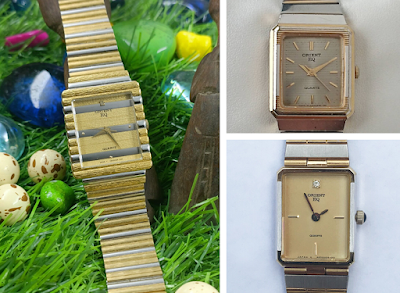When one looks for unconventional watch designs, one usually need look
no further than Orient. Historically, "Jump Hour" watches provided a
cool alternative to the standard hour-hand, minute-hand setup – and Direct Read
provided a simpler substitute to Jump Hour movements.
Before continuing, it might be worthwhile to clarify the distinction:
while both types of display show the hours and minutes using rotating discs
with digits printed on them, Jump Hour keeps the hour indication more or less
immobile until the minute disc returns to zero and pushes
the hour forward. With Direct Read, the hour wheel just keeps turning, in the
same way as the hour hand would normally.
While a Jump Hour mechanism is easier to read, as the hour is steady,
and more akin to digital displays, Direct Read watches are simpler to build,
since they just use regular movements and replace hands with discs. Orient
typically leans toward simpler movements, at least in non-Star models – so when
looking to provide a "mechanical digital" design, sometime in the mid-2000s, it adopted the Direct Read approach.
Reading this display is, well, fairly direct and simple – though it
requires some getting used to. In the picture above, for instance, the time is
about 10:08:36. You can see the thin red horizontal line pointing between 5 and
10 on the inner circle; look more closely and it's just past the 8. Those are
the minutes. The thicker red line you see is actually the second hand.
It's funny as this would be the time you'd normally see a watch in
Orient catalogs – with the hands arranged in the "smiley"
configuration. Of course it's quite meaningless when no hands are involved…
The date wheel is standard, appearing here as the outermost disc. The
date is read as usual through the small window at the bottom.
During the roughly ten years of producing direct read watches, Orient
made three main models, each having numerous versions differing mainly in
colors and choice of strap/bracelet. All of them have been discontinued a few
years ago.
The most familiar model, and the one that's easier to find online
nowadays, is the lugless design also known as the "Orbit" (a nickname
given to it by Orient USA I believe).
The Orbit's case was 35mm wide and 40mm long, and 12mm thick. Fairly
modest dimensions that were given enhanced wrist presence by its 28mm lug
width, fitted out of the box with a double-hole strap that did not taper too
much.
Inside the Orbit was Orient's caliber 48743, a reliable and robust
movement that had no problem turning those discs around. Cal. 487 variants are
typically identified in Orient's references as "ER". When searching the
web for this model, you could look for codes including "ERAM" or
"ERAK", as well as "Orbit".
The same movement was placed in a more conventional case to produce the
"Masquerade". It had considerably larger dimensions – 35.5mm width,
47mm lug to lug, and 13.5mm thickness. The strap was narrower than the Orbit's
though, at 25mm, enabling a single-hole structure.
When searching the web for this model, you could look for codes
including "ERAP" or "Masquerade". Note that some sellers
incorrectly refer to all Direct Read models by this name, so you might find some
Orbits that pop up when looking for the Masquerade.
Another important note (that is, if you care about these things…) concerns the movement. Apparently, at some point, this model was mistakenly
advertised as utilizing Orient's 46S50 movement, and this mistake was
repeatedly copied onto various articles and publications. That is not true –
46S50, recognizable by having "FH" in the reference, was a completely
different, no-date, small seconds caliber, used solely in semi-skeleton
watches.
Orient also produced a smaller version of the lugless model, a
"mini-Orbit" if you will, designated as a women's watch. This model
looked almost identical to the larger Orbit, having similar proportions and
dial layout. It was, however, only 28mm wide and 31mm long.
This model had a lug width of only 20mm – narrow enough to allow for
wearing it on a bracelet. The watch was indeed offered having both a steel
bracelet and a leather strap, similar to its bigger sibling.
Orient fitted the watch with its caliber 557, a smaller movement
typically reserved for ladies' watches (and which, despite its age, is still
being used in some current models). Cal. 557 has the same 40 hour power reserve
as the larger caliber 487, however its accuracy is not so impressive at +40 /
-30 seconds per day, compared to the 487's +25/-15.
Caliber 557 is identified by the letter "NR", and this model's
reference would typically include NRAK. When searching or shopping for an
Orbit, make sure you're looking at the right model – so you don't end up
ordering a watch that's too small, or too big.
Prices for pre-owned Orient direct-read models typically range between
USD 100-250. Personally I think paying up to USD 200 would be sensible, for a
watch in mint condition.
Photos in this post were taken from various old Orient publications
and sale ads.




















































